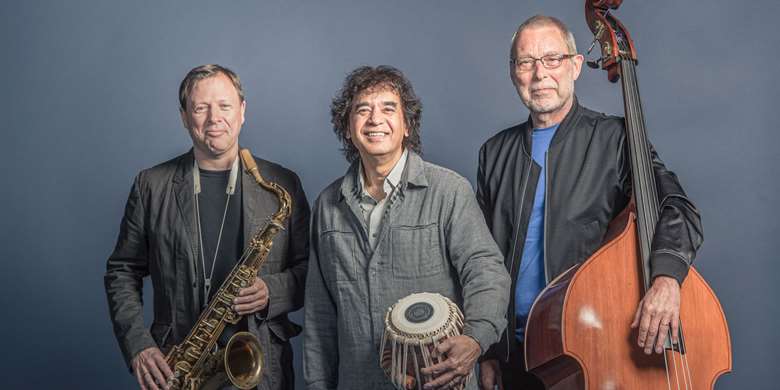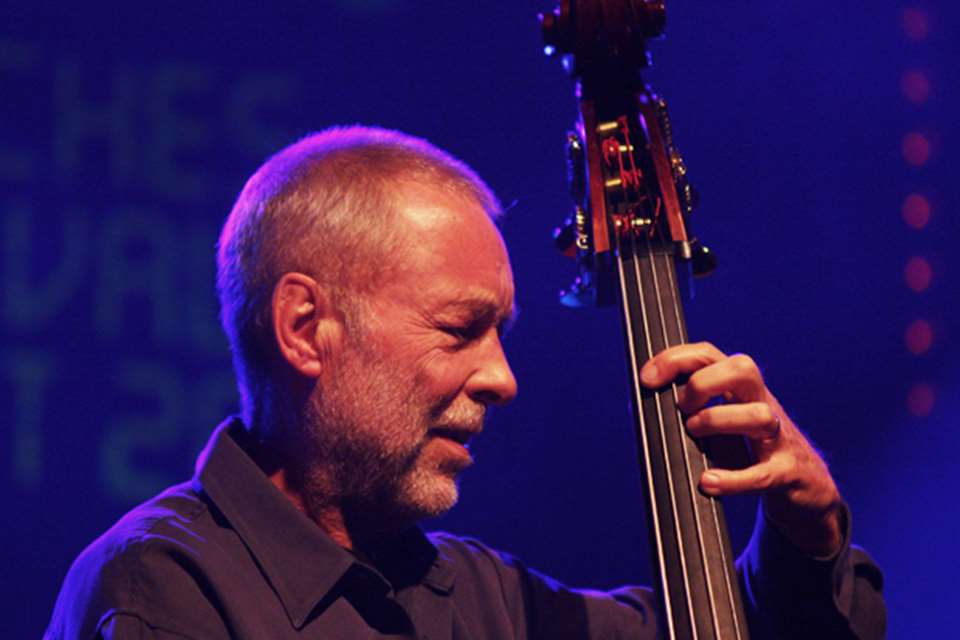Dave Holland: “You can improvise in open-form style for as long as you like, but you’ll never improvise ‘Giant Steps’”
Stuart Nicholson
Monday, November 25, 2019
Acclaimed double-bassist Dave Holland might have made his name performing with Miles Davis, Chick Corea and Anthony Braxton, but it is arguably on his own recordings that some of his most rewarding performances can be heard. Stuart Nicholson caught up with Holland before the release of his latest album, Good Hope, which matches him once more with his hotshot Crosscurrents trio featuring saxophonist Chris Potter and percussionist Zakir Hussain

The Conference of the Birds’ is a celebrated literary masterpiece by the 12th century Persian poet and Sufi mystic, Attar. It also happens to be a great title for a jazz album, and in 1972 bassist Dave Holland borrowed it for what would be his first recording as a leader. Today, Conference of the Birds is an enduring jazz classic whose inspiration runs through Holland’s trios, quartets, and quintets from the 1980s, 1990s and millennium years right up to the present day, including his latest release Good Hope (Edition), with saxophonist Chris Potter and Zakir Hussain on tablas and percussion. It represents a new direction for the 2017 NEA Jazz Master, whose passion for creative music of all styles now sees him exploring the long and vibrant relationship between jazz and Indian classical music, both of which have improvisation at their core.
The Good Hope project, initially known as The Crosscurrents Trio, has its origins in Zakir Hussain’s Crosscurrents band of three years ago, a nine-piece international supergroup which brought together Indian and American musicians that toured extensively in 2017, including headlining at the EFG London Jazz Festival in November. “During the concerts we did some large group things,” said Holland, “but we also broke it down into a few duets and a trio, which was Chris and myself and Zakir. And, as a result of that, we went to India with Zakir to play there and another tour in the States, and after that second tour we discussed doing a trio project because we enjoyed the intimacy of playing together – this was last year, last summer. We did a tour together during the summer and I said: ‘To me it feels great, we should go and record it,’ and that’s what we did last September”.
Holland emphasises that Indian traditional music of the north and the south of the sub-continent and jazz, “are probably the most developed improvisational musics that there are and bringing them together creates a rich musical language that expands the creative possibilities of both.” However, each follows its own unique laws and conventions. The challenge is to use the best of both musical worlds to create something unique and distinctive that reflects the musical personalities of the trio’s members: “Jazz music is more highly developed in the harmonic sense,” continues Holland. “Indian music uses static harmony. The rhythmic development in Indian music is extremely highly developed and involves rigorous training for the players in permutations of rhythms – in a sense it’s mathematical, it’s numeric, it’s dividing beats into smaller beats, and groupings of beats and long cycles and dividing those cycles up. So, to simplify it, the music has very much a dance quality to it, it’s rhythmic, it provides a lot of different roots and feelings in the compositions, but it has strong elements of both Indian music and jazz. Each musician brings what they have to the table, adding to the compositions in terms of interpretation and ideas that perhaps the composer hadn’t really considered, adding some very strong additional elements to the composition.”
Potter, who has been a member of Holland’s ensembles since a clutch of fine quintet albums that included 1999’s Prime Directive, 2001’s Not for Nothin’ and 2003’s Live at Birdland (all on ECM), initially admitted to being nervous of the exposed role for the saxophone in the group and the, “rather unfamiliar sonic territory” playing with tablas. But his misgivings were soon allayed by Zakir Hussain and Dave Holland, whom, he says, are two of the most amazing maestros on the planet.
With eight originals on Good Hope contributed by the trio members, Potter’s own composition provides the title-track. “It has elements of what you might hear in latin jazz in terms of rhythm,” explains Holland. “It’s an example of a tune that is very recognisable rhythmically and harmonically, and I think has a very direct impact on the listener. ‘Suvarna’ is a tune of Zakir’s and incorporates a very beautiful melody and Zakir added some beautiful chords that we play on, so again that’s a kind of hybrid tune. Then there’s a song of mine called ‘Lucky Seven’ and this is a tune in a seven-beat cycle which we have a lot of fun with and, again, it’s got a strong rhythmic propulsion to it. I think it was a real collaboration of cultures. I like to record material after its been performed for a while, because that gives us a chance to explore it, and personalise it, and more fully develop it… more than you could do if you just brought it into the studio and recorded it straight off.”
Holland has long been one of the most sought-after bassists in jazz, having performed with a virtual who’s-who of jazz, but it is on his own recordings that some of his most rewarding performances can be heard. But despite the critical plaudits for his steadily evolving small ensembles, using various combinations of instruments but never a piano, all roads lead back to Conference of the Birds from 1972. Two years earlier Holland had left Miles Davis, having participated on Davis’ groundbreaking albums In a Silent Way and Bitches Brew, to form the group Circle with Chick Corea, Anthony Braxton and Barry Altschul. The group lasted around 18 months and its recorded legacy includes Paris Concert (ECM), voted Album of the Year in Stereo Review and Jazz Hot.
In 1972, Holland joined the Stan Getz Quartet, worked with Thelonious Monk and began a long musical relationship with saxophonist Sam Rivers. “I started thinking about taking responsibility for an album, I’d always been collaborating on albums, and the first thing that occurred to me was: ‘Look, these are the people I want to play with, Anthony and Barry and let me think of something I could do with them!’ Now, around that time I started visiting Sam Rivers in his loft and doing some playing with him, sometimes for several hours non-stop, as Sam would do! So, when the record came together, I got the material I wanted to do and decided to bring together those three musicians – Sam, Anthony and Barry – and do the record with them. So we rehearsed and did a couple of gigs in New York and then went in the studio and recorded it in about six hours. After the record came out we had a few festivals in the summer of 1974, but what was captured so well and worked so well on the record didn’t work so well in live performance.
“So I spent the next few years working in Anthony’s groups in all kinds of situations, quartet, big band, duos, and the same with Sam. He had a big band, we did a lot of duo playing, so I kind of of jumped back and forth between the two groups until about 1976 and 1977 when I decided to focus on Sam’s music because both people were working a lot. I needed to focus on one thing really, so I settled on the thing with Sam.”
It was not until October 1983 that Holland became a bandleader again, creating some of the most enduring, widely admired and influential small group work of the period. “What happened in the early 1980s – well, a couple of things. One dramatic thing was that I got a very serious illness called endocarditis and was out of action for a year in 1982. During that time I was determined that, once I was better, I was going to start a group immediately, which I did as soon I was back in the saddle again. So I think it was really waiting for a sense of need [to form my own band] – I didn’t want to put a group together so I could ‘be a bandleader,’ that didn’t seem to be a good motive. I thought I needed to have something to say as a bandleader before I decided to take that step. That’s why I called it Jumpin’ In, because I had reached that point where I was ready to jump into it.”
Holland’s choice of line-up immediately set his band apart – Steve Coleman on alto, Kenny Wheeler on trumpet, Julian Priester on trombone and Steve Ellington on drums. Jumpin’ In (ECM) was followed November 1984 with Seeds of Time (ECM) with Marvin ‘Smitty’ Smith in on drums for Ellington and Razor’s Edge (ECM) from February 1987, with Robin Eubanks replacing Priester on trombone. These albums see Holland moving away from the open-form approach of Conference of the Birds and Jumpin’ In to more structured compositions: “What happened was coming out of the thing with Sam [Rivers]. My head was still very much into open-form playing, so I was structuring compositions around that idea and, as you say, that’s what was on Jumping In. Then, starting with Seeds of Time, there was some open on there, but I started to really understand that there were some things you could never achieve with open-form playing. To put it simply, you can improvise in open-form style for as long as you like, but you’ll never improvise ‘Giant Steps’. There was a reason Coltrane wrote ‘Giant Steps’. It was so that he could work on a particular approach to playing and there were things I wanted to work on, rhythmically, rhythmic forms, harmonic forms, that needed forms to set the direction. That’s the transition that happened then, and I’m still in that mode. I’m still moving between these two things.”
For many, what makes these albums so memorable was some exemplary playing by a young Steve Coleman, plus some of Kenny Wheeler’s finest soloing of his career, of which Holland simply says: “Magnificent, wonderful, wonderful. A dear friend and an incredible inspiration, I learned so much from playing his music, he had such a wonderful compositional sense and language. I owe so much to Kenny and, of course, the friendship as well and the opportunity to play on his records and play his music for so many years. It was a real honour and privilege.”
Holland’s small group ensembles continued evolving with personnel changes that brought the jazz world’s attention to important new talent, as well reminding them about established talent, a highpoint of his later bands 2003’s Extended Play: Live at Birdland (ECM) that leads us to the latest iteration of Holland’s bands on Good Hope (Edition). “I’m an equal opportunity employer,” says Holland. “I don’t think about anything to do with gender, race or age. I’m looking for the music. I am also conscious of the fact that it’s very important that there is intergenerational contact in the music. Older players should play with younger players and vice-versa, so we have a chance to cross-pollinate our influences and backgrounds. This is how the music grows and expands.”
This article originally appeared in the November 2019 issue of Jazzwise. Never miss an issue – subscribe today!
